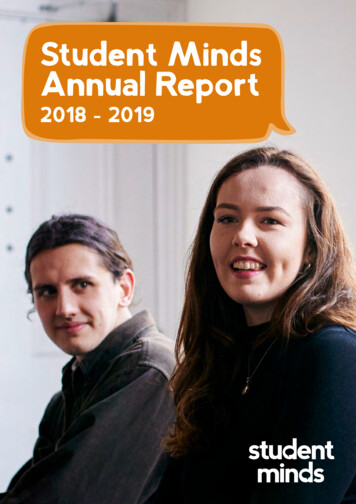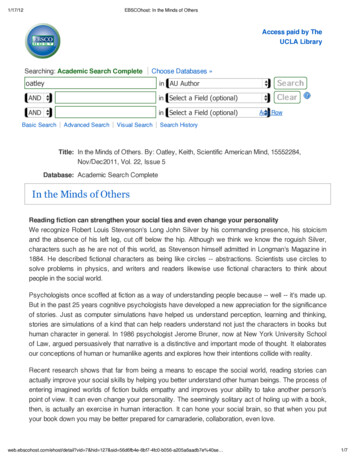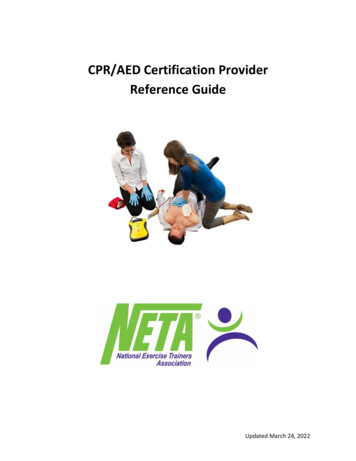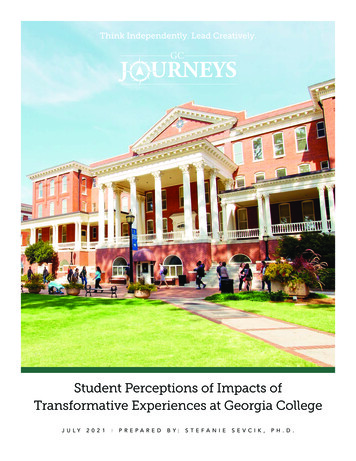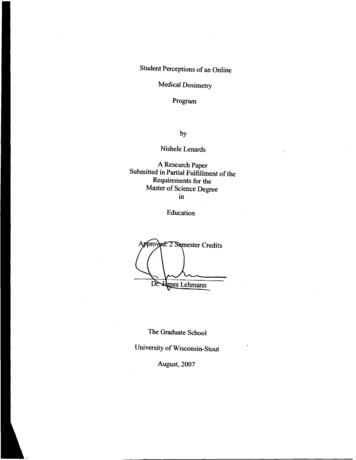
Transcription
Student Perceptions of an OnlineMedical DosimetryProgrambyNishele LenardsA Research PaperSubmitted in Partial Fulfillment of theRequirements for theMaster of Science DegreeInEducationester CreditsThe Graduate SchoolUniversity of Wisconsin-StoutAugust, 2007/
The Graduate SchoolUniversity of Wisconsin-StoutMenomonie, WIAuthor:Lenards, Nishele D.Title:Student Perceptions ofan Online Medical Dosimetry ProgramGraduate Degree/ Major: MS EducationResearch Adviser:James Lehmann, Ed.D.MonthlYear:August, 2007Number of Pages:73Style Manual Used: American Psychological Association, 5th editionABSTRACTThe University of Wisconsin - La Crosse offers the first web-based medical dosimetryprogram in the nation. There is no data to research a program of this type. This researchconsisted of the evaluation of other distance education programs including healthprofession programs in addition to face-to-face medical dosimetry programs. There wasneed to collect and analyze student perceptions of online learning in medical dosimetry.This research provided a guide for future implementation by other programs as well asvalidated the University of Wisconsin - La Crosse program. Methodology used consistedof an electronic survey sent to all previous and currently enrolled students in theUniversity of Wisconsin - La Crosse medical dosimetry program. The survey was bothquantitative and qualitative in demonstrating attitudinal perceptions of students in theprogram. Quantitative data was collected and analyzed utilizing a five point Likert scale.Qualitative data was gathered based on the open-ended responses and the identifyingthemes from the responses. The results demonstrated an overall satisfaction with thisprogram, the instructor, and the online courses. Students felt a sense of belonging to the
courses and the program. Considering that a majority ofthe students had never taken anonline course previously, the students felt there were no technology issues. Futureresearch should include evaluation of board exam statistics for students enrolled in theonline and face-to-face medical dosimetry programs.
ivTABLE OF CONTENTSABSTRACTiiList of TablesviChapter I: Introduction1Statement ofthe Problem4Purpose ofthe Study4Assumptions ofthe Study4Research Questions5Definition ofTerms5Limitations ofthe Study6Methodology7Chapter II: Literature ReviewChapter III: Methodology827Subject Selection and Description27Instrumentation28Data Collection Procedures30Data Analysis30Limitations31Summary31Chapter IV: ResultsItem AnalysisChapter V: DiscussionPurpose and ObjectivesData Collection3233383838
nces44Appendix A: Benchmarks for Success in Internet-based Distance Education54Appendix B: Cover Letter for Survey56Appendix C: Implied Consent Form57Appendix D: Survey ofUW-L Online Medical Dosimetry Program59Appendix E: Data Collection and Analysis64
VIList of TablesTable 1: General content of a web-based classroom13Table 2: Description of key players in a distance education program21Table 3: Common student perceptions in online learning surveys23Table 4: Survey results - satisfaction with the instructor.33Table 5: Survey results - satisfaction with online courses34Table 6: Survey results - satisfaction with online medical dosimetry program.34Table 7: Survey results - interaction with instructor and students.35Table 8: Survey results - comparison to face-to-face courses.37
Chapter I: IntroductionThe University of Wisconsin - La Crosse (UW-L) has the first and only onlinemedical dosimetry program in the nation. Medical dosimetry is a specialized field withinradiation oncology. Medical dosimetry students learn how to calculate and generateradiation dose distributions to treat cancerous tumors while limiting dose to normaltissue. The medical dosimetry training programs consists of online didactic curriculumand clinical internship training in a radiation oncology department. Didactic courseworkin the healthcare professions is the medical teaching by lectures or textbooks (Merriam Webster, 2002). The clinical internship training is student involvement in directobservation and treatment of patients in a clinical setting (Merriam-Webster, 2002).Medical dosimetry programs are traditionally face-to-face instructor-led learningenvironments in which didactic and clinical internship training take place at an accreditedmedical institution. The only difference in the UW-L program versus the traditional face to-face medical dosimetry programs is that the didactic coursework is delivered viaonline education.There is a need to research student perceptions of the UW-L online program tomake improvements for future students as well as validate the program for theestablishment of future online medical dosimetry programs. The evaluation by studentswas in regards to student learning, online experiences, communications, and perceptionsof difficulty, ease, and differences in online courses. Because the program is new andthere are no other web-based medical dosimetry programs, this research is now moreimportant than ever.
2Online education, or web-based learning, is distance education over the Internet.This distance education can be delivered to remote (non-campus) locations viasynchronous, asynchronous, instructor-led or computer-based means of instruction (ChelaEducation, 2006). Courses can be delivered in a format ofreal-time, self-paced, or acombination of both. Distance education is not a new concept. Gunderson (2006) gives ahistorical perspective of distance education:In early 1700's, advertisements first appeared for courses offered by mail throughcorrespondence study. During the 1960s and 1970s, distance learning wasexpanded to geographically isolated areas with the advancement of technologies.In the 1980s, there was a greater need for distance education and moreopportunities due to teacher shortages. Today, we have more computer-basedinteractions, using the Internet and the World Wide Web. The educationalinstitutions are now present in the home and workplace around the world (p. 6).A key issue in online educational delivery is how moving away from traditional face-to face relationships between the professor and the student impact student learning and theirperceptions ofleaming (O'Malley & McCraw, 1999). Over the years, much of theresearch has focused on technical issues of online learning and less attention to studentperceptions of online learning. This study evaluated perceptions of students thusproviding feedback for changes to be implemented in this program.There is an urgent need for the establishment of new medical dosimetry programs,be it face-to-face or online. There are a limited number of programs that exist in thisnation which contributes the to excessive workforce shortage of medical dosimetrists.According to a 2002 survey of the Workforce Committee ofthe American Society for
3Therapeutic Radiology and Oncology (ASTRO), approximately 700 medical dosimetristswere needed nationwide, which was a 35% increase in workforce at that time (2003).Additionally, only about 25 to 30 individuals were graduating from the eight formalprograms at that time. Currently, there are approximately 15 medical dosimetry programsin this nation, with only four of those being degree-granting programs. Many students inthis nation live at great distance from the site of a medical dosimetry program and do nothave the option or ability to relocate. The need to train those who do not live close to amedical dosimetry program is what led to the initiation of an online medical dosimetryprogram at UW-L. The online program offers the unique ability to serve various studentsthroughout the United States as well as improve the workforce shortage in thisprofession. The establishment of additional online medical dosimetry programs couldalso help to alleviate the limited educational opportunities in medical dosimetry as wellas improving the workforce shortage.There is no data available regarding online medical dosimetry programs becausethere are no other online programs that exist. Therefore, this increases the need toresearch this topic, validate the UW-L medical dosimetry program, and use as a modelfor the establishment of new online medical dosimetry programs in the future. Researchincluded other online healthcare programs but data was limited in this area as well. Thisstudy provided information regarding components of distance learning, characteristics ofindividuals in the study, structure of online courses, experiences of other healthprofession programs utilizing online learning, structure of face-to-face medical dosimetryprograms, and surveys assessing student perceptions. Researchers have identified severalvariables that can affect students' perceptions of online instruction, including prior
4computer experience, peer and teacher/student interaction, and institutional support(Ivers, Lee, & Carter-Wells, 2005). Those variables were evaluated in this survey toimprove the program and offer data to be use for establishing new online medicaldosimetry programs.The technology of computers and the Internet have a major effect on students'online learning experiences. "As distance education becomes more popular, and astraditional courses require more online assignments, teachers must consider students'perceptions of online learning" (Peters, 2001, p.l).Statement ofthe ProblemThe UW-L is the first web-based medical dosimetry program in the nation. Thereis no data to research a program of this type. However, data can be researched in regardsto overall distance education, other web-based health profession programs, and face-to face medical dosimetry programs. There was a need for data to be collected and analyzedof students' perceptions of online learning in this type of program. A study of onlinelearning in a medical dosimetry program needed to be completed to provide a guide forfuture program implementation by other institutions throughout the nation and to validatethe current program that exists.Purpose ofthe StudyThe purpose of the study was to analyze student perceptions of an online medicaldosimetry program at UW-L. The study will serve to improve and validate the programas well as provide data for implementation of new programs.Assumptions ofthe StudyThe assumptions of the study were that students would provide informative
5feedback that would be used to improve the online delivery ofthe program. The datawould be used to establish a model for future online programs.Research QuestionsThe study sought to answer these questions:1. What are student perceptions of the online medical dosimetry program?2. What are student perceptions of peer interaction and student/teacher interactionin the online courses?3. What previous experience did students have with technology required of themin the online program? What is their level of comfort with the technology?4. How does their motivation of online learning affect their perception ofthequality ofthe online program?5. What steps could be taken to improve the online medical dosimetry program?6. Is the quality ofthe online courses equal to previous face-to-face courses?Definition ofTermsMedical Dosimetrist. A member of the radiation oncology team, who hasknowledge of the overall characteristics and clinical relevance of radiation oncologytreatment machines and equipment, is cognizant of procedures commonly used inbrachytherapy and has the education and expertise necessary to generate radiation dosedistributions and dose calculations in collaboration with the medical physicist andradiation oncologist (AAMD, 2006).Medical Dosimetry. The calculation and generation of radiation dose distributionfollowing a radiation oncologist's plan for treatment while utilizing physics, math,
6anatomy, and radiobiology to design optimal treatments that target the tumor and sparehealthy normal tissue around it.Online medical dosimetry program. A program in which didactic courses arecompleted asynchronously via the web while clinical internship training is taking place atan accredited healthcare institution.Face-to-face program. A teacher-directed environment with interaction in a livesynchronous, high fidelity environment (Graham, 2005).Distance Learner. A student who spends most ofhislher class time andcoursework in an off-campus site or at home (Hunter Library, 2006).Asynchronous. Literally means "not at the same time". An asynchronous course isone in which the instruction is delivered at one time and the work can be done at adifferent time. Students and teachers use e-mail, listservs, and other technologies tocommunicate without having to be in the same place at the same time (Ohio LearningNetwork,2006).Web-based. A major service on the Internet (Farlex, 2006).Online learning. A learning experience or environment that relies upon theIntemetlWWW as the primary delivery mode of communication and presentation(Intelera, 2004).Internet. A worldwide, interconnected system of computer networks (EducationWorld, 2006).Limitations ofthe StudyThere were limitations in this study including the fact that there are no othermedical dosimetry programs to compare this study to. This is the first and only online
7medical dosimetry program in the nation. There are a limited number of face-to-facemedical dosimetry programs to evaluate when comparing the quality of this onlineprogram to those. Finally, the UW-L online medical dosimetry program is relatively newso the number of responses received from students was less than desirable.MethodologyA review ofliterature was conducted on student perceptions of online learning aswell as the evaluation methods to consider when surveying the students. Research ontraditional face-to-face medical dosimetry programs as well as other online healthprofession programs was used when evaluating the quality of this online program.The researcher conducted a survey of student perceptions in this online medicaldosimetry program in which all previous and current students received the electronicsurvey. The data was collected and analyzed for the results of the study.
8Chapter II: Literature ReviewIntroductionMedical dosimetry is the calculation and generation of radiation dose distributionsfollowing the physician's prescription for treatment (AAMD, 2006). Medical dosimetryutilizes math, physics, anatomy, and radiobiology to generate the radiation dosedistributions and calculations for treating patients' cancerous tumors while avoiding thenormal tissues. The UW-L offers a Web-based medical dosimetry program which is thefirst and only of its kind in the nation. This program has many advantages of providingonline education to adult learners throughout the nation who have no access to a programin their region of the country. Historically, medical dosimetry programs have beentraditional face-to-face programs. In this literature review, the structure of medicaldosimetry programs, online or traditional face-to-face was reviewed. Online healthprofession programs were reviewed as well. In order to describe the online component ofthe UW-L program, the structure of online courses and components of distance learningneeded to be discussed in detail. Medical dosimetry programs involve the education ofadult learner students. The individuals described in this study were characteristic ofonline students, adult learners, and online instructors. Finally, since the purpose of thestudy was to evaluate student perceptions in an online medical dosimetry program,studies about general student perceptions of online education and affecting factors werereviewed.Structure ofMedical Dosimetry ProgramsTraditionally, medical dosimetry programs are designed as face-to-face programs.The curriculum consists of both didactic and clinical coursework. Didactic coursework in
9the healthcare professions is the medical teaching by lectures or textbooks (Merriam Webster, 2002). This lecture or textbook instruction differs from the clinicaldemonstration and laboratory study for clinical curriculum. Clinical curriculum inhealthcare professions is student involvement in direct observation and treatment ofpatients in a clinical setting (Merriam-Webster, 2002). In traditional face-to-face medicaldosimetry programs, students go to a physical classroom where the instructor gives adidactic lecture and students listen and take notes. Generally this consists of onlyapproximately 8 to 12 hours per week. For the remainder of the week students completethe clinical coursework in a patient care setting at a medical facility which is affiliatedwith the program. The actual hours of student didactic and clinical curriculum have notbeen established as a standard requirement in medical dosimetry educational programs. Itis at the discretion of the program directors to establish the clinical and didacticcomponent of the program. In the field of radiation therapy, where medical dosimetry isperformed, students must demonstrate competence in clinical activities under theobservation of a qualified instructor (ARRT, 2005). Didactic competence is accomplishedwhen students successfully complete coursework recommended by the professionalcredentialing organization (ARRT, 2005). To date, medical dosimetry educationalprograms do not have clinical and didactic competency requirements, therefore radiationtherapy guidelines (ARRT, 2005) as well as the AAMD educational curriculum (AAMD,2000) are followed.With respect to online education, "Teaching without the teacher's personalpresence in the classroom to provide direct instruction is a modem day miracle of 21 stcentury education" (Beard & Harper, 2002, p.658). The online medical dosimetry
10program at UW-L is somewhat a modem day miracle in medical dosimetry education.Although the first of its kind, the program also consists of both didactic and clinicalcourseworkjust as the traditional face-to-face medical dosimetry programs do. The UW L didactic coursework is delivered by means of a Web-based distance education learningplatform at the University which is accessed via the Internet. The coursework can becompleted at any time of the day. The instructor and the students are not physicallypresent in a classroom but do interact with each other via distance educationopportunities. In online education, opportunities for direct communication betweenteacher and students are in the form of e-mail, discussion boards, and virtual chat rooms(Beard & Harper, 2002). Other forms of communication can be via telephone, mail, andvideo-camera via the Internet. The clinical coursework is delivered in the same format asa traditional face-to-face medical dosimetry program. The students complete a face-to face clinical internship in a patient care setting at a medical facility affiliated with theprogram. The clinical instructors provide the instruction to the students in the health caresetting.Online learning in health profession programsHealth profession programs consist of didactic and clinical curriculum. This isbecause the students cannot be educated in a health care field without clinical internshipin a patient care setting at a medical facility. Nursing program accreditation requires bothclinical and didactic components for a program to receive accreditation by the NationalLeague for Nursing Accreditation Commission (NLNAC, 2005). The Accreditation Councilfor Occupational Therapy Education (ACOTE) standards require both didactic andclinical curriculum for a program to receive accreditation (ACOTE, 2006). Physical
11therapy programs are required to have didactic and clinical components as governed bytheir accrediting organization, Commission on Accreditation in Physical TherapyEducation (CAPTE, 2006). The Joint Review Committee on Education in RadiologicTechnology (JRCERT) established standards for accreditation of radiologic technologyprograms, radiation therapy programs, magnetic resonance imaging programs, andmedical dosimetry programs. All ofthese programs are required to include didactic andclinical curriculum in their programs (JRCERT, 2006). Health profession programs mustinclude both components in their program in order to receive accreditation and studentsmust achieve competence in clinical and didactic curriculum in order to graduate fromthe program. These standards establish the validity and effectiveness of education forstudents while promoting patient safety in the healthcare environment.These standards and requirements are no different in an online health professionprogram. The only difference in a Web-based program is that the didactic coursework canbe completed online. The student will still be required to complete the clinical internshipcomponent which involves direct patient care and technical education on appropriateequipment within the department. Web-based courses are delivered in an asynchronousformat allowing institutions and faculty to present course materials to students at a placeand time of their choosing (Grimes, 2002). "Traditional classroom education can posetime and physical proximity barriers for the adult learner who is attempting to completehigher education" (Townsend et aI., 2002, p.3)."It is clear that technology has become an integral part ofthe health professional'sworkplace" (Townsend et aI., 2002, p. 2). Health profession graduates must besophisticated in the use of information technologies and understand how these
12technologies interface with various health care systems. Online courses allow students theuse of Internet and other various information technologies which will be used in theirprofessional careers after graduation. An article in the Journal of Nursing Education titled"Enabling student nurses to use the information superhighway" stated that the benefits ofonline course delivery are especially crucial for growing numbers of nursing studentswho simultaneously juggle responsibilities in the workplace and at home, as well as forthose students who are at distance education sites (Bachman & Panzarine, 1998). It isclear that the flexibility of Web-based courses offers an option for working professionals,adult learners, and rural students.Distance education programs vary in their design and utilize a variety oftechniques to bridge the time and space gap between the teachers and students (Treloar,1998). Instructors need to be aware of the impact that their social presence or lack thereofmay have on their students' satisfaction, motivation, and learning (Richardson & Swan,2003). The key issue that must be addressed is how these new online delivery approachesthat move away from face-to-face relationship between instructor and students impactlearning and student perceptions of learning.Structure ofonline courseworkColleges and universities have been investing a great deal of effort and resourcesto modify existing face-to-face courses to meet the specific characteristics of onlinelearning environments. Several studies and resources are available that identify the keycomponents of online coursework to increase the outcomes of online learning (Chapman,2005; Gerson, 2000; Hricko, 2002; IHETS, 2006; MSU, 2005; & Willis, 1995). It ispossible that with all components in place, the success of online courses rests in the
13perception of the student. As with any product in the marketplace, this successdetermines whether students continue to enroll in online courses.No two online courses will be the same anymore than two professors will teachexactly the same way. Although online courses are not all the same, the structure of thecourses is similar in all Web-based learning platforms. In general, online courses consistof: course/faculty information; announcements/lessons; external resources; discussionboards/groups areas/ communication; and end of course assignments/assessments.In 2002, Hricko studied the development of a Web-based classroom and quoted ahandout presented by Zaccaria (2000) titled "Criteria for an Effective Instructional Website" in which he described the general content of a web-based classroom. Table 1 liststhe general content of a web-based classroom. Ells (1998) stated in an online workshopthat making content available is not education. He said that learning requires action,interaction, and application.Table 1General Content ofa Web-based ClassroomInstructor information, virtual office hours,announcementsCourse description, course outlines, syllabi,and assignmentsLecture outlines, class notes, and webbibliographiesTesting and grading information, sampletests or test questionsCourse management policies, means forsubmission of assignmentsInteractive activities such as bulletin board,email links to classmatesAcademic services support links such asthe campus library and tutoring centerLinks appropriate to lecture to assiststudents with review of materialGrade postings and/or a site by whichstudents can check assignmentsPassword protection for pages withpersonal student content
14On the surface, the structure of an online course does not differ much from aclassroom course. Each component is present in both kinds of educational deliverysystems. However, a common mistake of faculty is to try to reproduce a classroomenvironment in creating an online course. The challenge is not to create an onlineclassroom; the challenge is to create a personal learning experience for students over theWeb that takes full advantage of its incredible capabilities.Howland and Moore (2002) stated that online courses require at least the sameamount of work, if not more, for both students and instructors. They stated that timerequirements increase due to the nature of electronic communications. For example,written discussions in online format take much longer than the verbal discussion takingplace in a classroom. The reason for this is that in a face-to-face lecture, the instructor canquickly assess student comprehension, but in online courses it becomes very difficult todo this. Instructors also spend more time trying to orientate students in the online learningenvironment. Howland and Moore (2002) also stated that the instructional strategy usedwill not fit all learners, therefore requiring flexibility of all individuals involved.Although flexibility is seen as advantageous, the instructor must provide some guidelinesfor the number of times per week a student is required to be online in the discussionboard or how much time should be allocated for coursework completion. Instructors mustkeep students engaged in periodic correspondence in order to keep them interested andconnected. The more correspondence with the student, the less isolation felt by thestudent (Howland & Moore, 2002). Finally, instructors should establish the technologicalmaterials needed to improve the quality of learning prior to student enrollment.
15As instructors continue to be challenged by the design of online courses, theymust also learn how to keep students engaged without increasing workload for studentsand instructors. Instructors must use the power of technology to create a new generationof more adaptive and flexible thinkers. The technology offers capabilities of doing abetter job while meeting challenges of communication, management of time, andassessment.Characteristics ofIndividuals in StudyDistance education opportunities have brought the classroom from the universitysetting to the home, allowing students the privilege to pursue college degrees without theinconvenience of actually traveling to campus for course completion (Beard, 2004).O'Malley and McCraw (1999) describe the increased change in types of student learners:Until the late 1980's, the primary educational delivery model for collegiateprofessorial staff was essentially the traditional lecture. Student populationsconsisted of single, residential eighteen to twenty-three year oIds, althoughworking, non-traditional students had begun to increase dramatically. As weapproach the year 2000, the student population has continued to change tomarried, employed, and non-residential students (p. 1).The increase in adult learners is due to the increase in technology allowing distanceeducation opportunities for these types of students as well as the need to retrain in adifferent career field. We not only see an increase in online learners, but we also see anincrease in adult learners as well.The distance education delivery methods allow working adults to pursue theireducation without interrupting their careers. Willis (1995) describes the profile ofthe
16distance learner as older, employed, with families who must coordinate different areas oftheir lives which influence each other. They have a variety of reasons for taking courses.These learners are isolated learners who utilize technology as the conduit through whichinformation and communication flow. They also have little in common with the instructorin terms of background and day to day experiences, therefore, taking longer for thestudent-instructor rapport to develop.Online learning has no geographic boundaries. It reduces preconceived notionsbased on students' age, gender, race, background, or level of experience. This type oflearning has the ability to promote contemplative and reflective learning while providingindividualized attention with depth of interaction by instructors and students not possiblein a large classroom. Online learning is flexible and convenient. Although these are allbenefits of online learning, there are disadvantages for online students as well. Distanceeducation students have feelings of isolation (Howland & Moore, 2002; Ivers et al., 2005;Peters, 2001; Smith, 2005; & Yilman & Tuzun, 2001). They may feel thatcommunication is lacking between students and with the instructor. These students tendto procrastinate and can sometimes get off-track. Some students need direct interactionwith instructors and students, therefore making distance education a more difficultchoice. A
Student Perceptions ofan Online Medical Dosimetry Program. by. Nishele Lenards. A Research Paper Submitted in Partial Fulfillment ofthe Requirements for the Master of Science Degree. In . Education . ester Credits The Graduate School University of Wisconsin-Stout August, 2007 /

